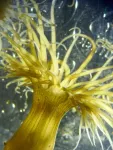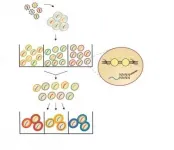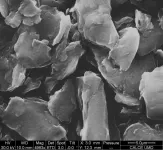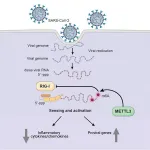(Press-News.org) URBANA, Ill. - With threats of water scarcity complicating the need to feed a growing global population, it is more important than ever to get crop irrigation right. Overwatering can deplete local water supplies and lead to polluted runoff, while underwatering can lead to sub-optimal crop performance. Yet few farmers use science-based tools to help them decide when and how much to water their crops.
A new University of Illinois led study identifies obstacles and solutions to improve performance and adoption of irrigation decision support tools at the field scale.
"We wanted to offer our perspective on how to achieve field-scale precision irrigation with the most recent and advanced technologies on data collection, plant water stress, modeling, and decision-making," says Jingwen Zhang, postdoctoral researcher in the Department of Natural Resources and Environmental Sciences (NRES) at Illinois and lead author on the article in Environmental Research Letters.
Zhang says many farmers rely on traditional rules of thumb, including visual observation, crop calendars, and what the neighbors are doing, to decide when and how much to water. Better data and more advanced technologies exist to help make those decisions, but they aren't being leveraged currently to their full potential.
For example, some fields are equipped with soil moisture sensors or cameras that detect changes in crop appearance, but there aren't enough of them to provide accurate information across fields. Satellites can monitor vegetation from space, but the spatial and temporal resolution of satellite images is often too large to help make decisions at the field scale.
Kaiyu Guan, assistant professor in NRES, Blue Waters professor with the National Center for Supercomputing Applications, and project leader on the study, pioneered a way to fuse high-resolution and high-frequency satellite data into one integrated high spatial-temporal resolution product to help track soil and plant conditions.
"Based on remote sensing fusion technology and advanced modeling, we can help farmers get a fully scalable solution remotely," he says. "That's powerful. It can potentially be a revolutionary technology for farmers, not only in the U.S., but also smallholder farmers in developing countries."
With modern satellite technology and Guan's fusion model, data acquisition won't be a limiting factor in future precision irrigation products. But it's still important to define plant water stress appropriately.
Historically, irrigation decisions were based solely on measures of soil moisture. Guan's group recently called for the agricultural industry to redefine drought, not based on soil moisture alone, but on its interaction with atmospheric dryness.
"If we consider the soil-plant-atmosphere-continuum as a system, which reflects both soil water supply and atmospheric water demand, we can use those plant-centric metrics to define plant water stress to trigger irrigation," Zhang says. "Again, if we use our data fusion methods and process-based modelling, we can achieve precision irrigation with very high accuracy and also high resolution."
The researchers also looked at challenges regarding farmer adoption of existing decision support tools. Because current products are based on less-than-ideal data sources, Guan says producers are reluctant to switch from traditional rule-of-thumb methods to tools that may not be much more reliable. Non-intuitive user interfaces, data privacy, and inflexible timing compound the problem.
Trenton Franz, associate professor at the University of Nebraska-Lincoln (UNL) and a coauthor, says farmers will be more likely to adopt precision irrigation decision tools if they are accurate down to the field scale, flexible, and easy to use. His and Guan's teams are working on technologies to fill this need and are actively testing the technology in irrigated fields in Nebraska. This includes participating with Daran Rudnick, assistant professor at UNL and co-author of the study, in the UNL Testing Ag Performance (TAPS) program, which focuses on technology adoption and education for producers across the region.
"We're pretty close. We have real-time evapotranspiration data, and we're adding the soil moisture component and the irrigation component. Probably in less than a year this will be launched as a prototype and can be tested among the farmer community," Guan says.
INFORMATION:
For more detail, see the article, "Challenges and opportunities in precision irrigation decision-support systems for center pivots," published in Environmental Research Letters [DOI: 10.1088/1748-9326/abe436]. Additional Illinois co-authors include Bin Peng, Chongya Jiang, Wang Zhou, Yi Yang, Yaping Cai, and Madhu Khanna, professor in the Department of Agricultural and Consumer Economics and interim director of the Institute for Sustainability, Energy, and Environment (iSEE).
This project is primarily funded by the USDA NIFA Cyber-Physical System Program and an NSF CAREER Award through its Environmental Sustainability Program.
The Department of Natural Resources and Environmental Sciences and the Department of Agricultural and Consumer Economics are in the College of Agricultural, Consumer and Environmental Sciences (ACES) at the University of Illinois. The Agroecosystem Sustainability Center is a joint research center of ACES and iSEE.
Researchers at Karolinska Institutet and the Public Health Agency of Sweden have studied newborn babies whose mothers tested positive for SARS-CoV-2 during pregnancy or childbirth. The results show that although babies born of test-positive mothers are more likely to be born early, extremely few were infected with COVID-19. The study, which is published in the esteemed journal JAMA, supports the Swedish recommendation not to separate mother and baby after delivery.
The population-based study comprised 92 per cent of all neonates - almost 90,000 births - in Sweden during the first year of the pandemic (11 March 2020 to 31 January 2021), making it one of the largest datasets in the field to date.
The results show a slightly higher level of morbidity ...
During the first wave of the corona pandemic, 36 per cent fewer men were diagnosed with prostate cancer in Sweden than in previous years. On the other hand, the number of patients receiving curative treatment for prostate cancer was unaffected. This is shown by a new register study led by Uppsala University researchers, whose results are published in the Scandinavian Journal of Urology.
"We think the number of cases diagnosed fell because, early on, the Public Health Agency of Sweden urged older people to minimise their social contacts and, by the same token, refrain from non-urgent ...
Microalgae of the dinoflagellate group are known for their ability to survive in other animal cells. These tiny single-cell organisms have engaged in mutually beneficial relationships with corals since primeval times. By passing on critical nutrients to their hosts, dinoflagellates allow corals to thrive even in barren areas. A research team from the Centre for Organismal Studies (COS) of Heidelberg University recently discovered that such symbioses within the cell essentially depend on the ability of the algae to suppress the immune system of their host cell and thereby avoid being "spit ...
Nearly half of adults in the United States have hypertension, a condition that raises the risk for heart disease and stroke, which are leading causes of death in the U. S.
At Baylor College of Medicine, Dr. David J. Durgan and his colleagues are dedicated to better understand hypertension, in particular the emerging evidence suggesting that disruption of the gut microbiota, known as gut dysbiosis, can have adverse effects on blood pressure.
"Previous studies from our lab have shown that the composition of the gut microbiota in animal models of hypertension, such as the SHRSP (spontaneously hypertensive stroke-prone ...
The outbreak of COVID-19 has revealed the widespread effects a pandemic can have on all spheres of life from health, to social life, to the economy. The main thrust of efforts to control the spread has been to decrease the reproduction rate to flatten the curve of the total number of infected individuals per day in order to reduce overload on the health system. The most widely implemented response to the exponential growth of the infection has been widespread quarantine and lockdown. While isolation is an effective tool to decelerate the spread, repeatedly imposing complete ...
Small and medium-sized manufacturing enterprises (SMEs) face many obstacles and difficulties (economic, technical, cultural, etc.) when it comes to implementing Industry 4.0. "These are transition processes that are economically costly, and in which SMEs often come up against technical and cultural problems, as they are not cognizant of how to make this transition, or of the benefits their companies stand to gain by implementing Industry 4.0," explained the UPV/EHU pre-doctoral researcher Víctor Ramírez-Durán.
While several pieces of work address the incorporating ...
NEW YORK, NY (April 29, 2021) - In a new resource for the scientific community, published today in Nature Biotechnology, researchers in the lab of Neville Sanjana, PhD, at the New York Genome Center (NYGC) and New York University (NYU) developed CRISPR-sciATAC, a novel integrative genetic screening platform that jointly captures CRISPR gene perturbations and single-cell chromatin accessibility genome-wide. With this technology, they profile changes in genome organization and create a large-scale atlas of how loss of individual chromatin-altering enzymes impacts the human genome. The new method harnesses the programmability of the gene editing system CRISPR to knock-out ...
Exploring extreme environments can put significant operational challenges on the engineering systems we depend upon to safely explore and at times operate within.
Within high-value and safety-critical applications, such as space exploration or sub-surface drilling, the extreme and at times dynamic operating conditions within the environment, can make it challenging to understand the life expectancy of critical components and sub-systems. Hence, it's a highly complex and at times impossible situation to accurate understand therefore predict.
To have safe, resilient and economically viable operations within these challenge environments, it is vital ...
Researchers at University of California San Diego School of Medicine have discovered one way in which SARS-CoV-2, the coronavirus that causes COVID-19, hijacks human cell machinery to blunt the immune response, allowing it to establish infection, replicate and cause disease.
In short, the virus' genome gets tagged with a special marker by a human enzyme that tells the immune system to stand down, while at the same time ramping up production of the surface proteins that SARS-CoV-2 uses as a "doorknob" to enter cells.
The study, published April ...
The burden of student loans in the U.S. continues to grow unabatedly, currently accounting for a total of $1.7 trillion in household debt among nearly 45 million borrowers. "The introduction of income-based repayment over the past decade has made student loans rather complicated products," Paolo Guasoni of Dublin City University said. As borrowers navigate this complex process, they face long-term consequences; people with student debt are less likely to own homes or become entrepreneurs, and generally postpone their enrollment in graduate or professional studies. Though legislative reform is necessary to combat this problem on a grand scale, individual borrowers can take steps to ...







